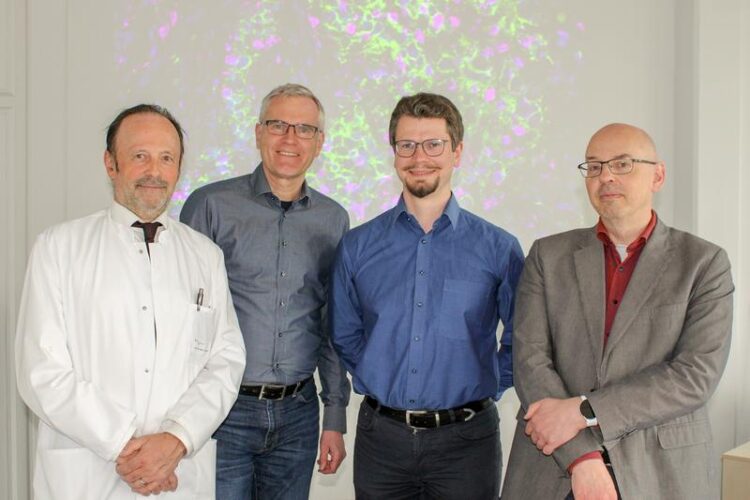A perfect match for brain tumour therapy

From left, Professor Dr. Joachim Krauss, Professor Dr. Herbert Hildebrandt, Dr. Hauke Thiesler and Professor Dr. Christian Hartmann in front of the image of an immunostained sectional preparation from a glioblastoma.
Copyright: Maike Isfort / MHH
Feature combination of Siglec-16 and polysialic acid increases survival in patients with glioblastoma.
Glioblastomas are malignant brain tumours with a poor prognosis because they usually do not respond to common cancer therapies. One reason for this is that the tumour cells have developed mechanisms to evade immune defence. Even more: certain cells of the innate immune system, so-called tumour-associated macrophages (TAM), are influenced in such a way that they not only do not attack the tumour cells, but even stimulate tumour growth.
Researchers at the Institute of Clinical Biochemistry at the Hannover Medical School (MHH), in collaboration with specialists from the Neuro-oncology Centre led by Professor Hartmann from Neuropathology and Professor Krauss from Neurosurgery, as well as with partners from the University Medical Center Göttingen (UMG), are now demonstrating a new mechanism that improves survival in glioblastomas. The cross-site research under the umbrella of the Neuro-oncology Working Group of the Comprehensive Cancer Center Lower Saxony (CCC-N) was able to prove that patients with glioblastoma survive longer after resection of the primary tumour if the tumours produce a factor called polysialic acid and at the same time their TAMs have an immune receptor called Siglec-16 that recognises polysialic acid. The results were published in the renowned journal Clinical Cancer Research.
Tumour-inhibiting effect
“With the trait combination of Siglec-16 and polysialic acid, we observed a tumour-inhibiting effect,” says Professor Dr Herbert Hildebrandt, project leader in the DFG-funded research group 2953 “Sialic acid as a regulator in development and immunity” and working group leader at the Institute of Clinical Biochemistry at MHH. “Through experiments on glioblastoma cells and macrophages in cell cultures, these changes could be directly attributed to the activation of Siglec-16 by polysialic acid.”
“Remarkably, due to a naturally occurring gene mutation, only part of the population is able to produce Siglec-16, while polysialic acid could be detected in more than 80 per cent of the glioblastomas examined,” adds Dr Hauke Thiesler from Professor Hildebrandt’s research group. “A simple genetic test in combination with other factors could enable a more precise individual prognosis.” Furthermore, should it be possible to mimic the activating properties of Siglec-16 with drugs, this could help to improve glioblastoma therapy.
SERVICE:
You can find the original paper here: https://aacrjournals.org/clincancerres/article-abstract/doi/10.1158/1078-0432.CC…
For further information, please contact Professor Dr Herbert Hildebrandt, Hildebrandt.Herbert@mh-hannover.de, phone (0511) 532-9808
Media Contact
All latest news from the category: Health and Medicine
This subject area encompasses research and studies in the field of human medicine.
Among the wide-ranging list of topics covered here are anesthesiology, anatomy, surgery, human genetics, hygiene and environmental medicine, internal medicine, neurology, pharmacology, physiology, urology and dental medicine.
Newest articles

Largest magnetic anisotropy of a molecule measured at BESSY II
At the Berlin synchrotron radiation source BESSY II, the largest magnetic anisotropy of a single molecule ever measured experimentally has been determined. The larger this anisotropy is, the better a…

Breaking boundaries: Researchers isolate quantum coherence in classical light systems
LSU quantum researchers uncover hidden quantum behaviors within classical light, which could make quantum technologies robust. Understanding the boundary between classical and quantum physics has long been a central question…

MRI-first strategy for prostate cancer detection proves to be safe
Active monitoring is a sufficiently safe option when prostate MRI findings are negative. There are several strategies for the early detection of prostate cancer. The first step is often a…



